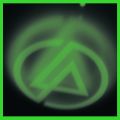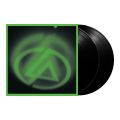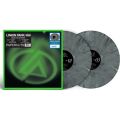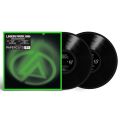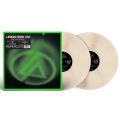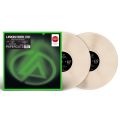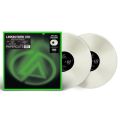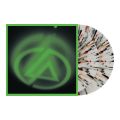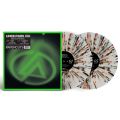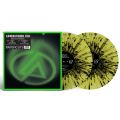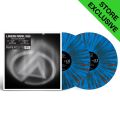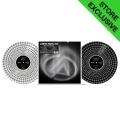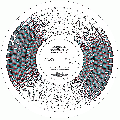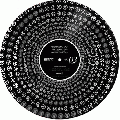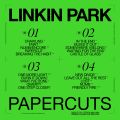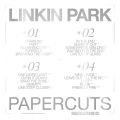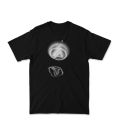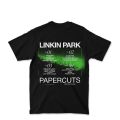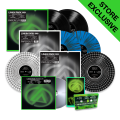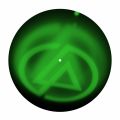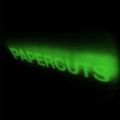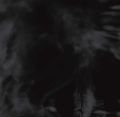No edit summary |
|||
| Line 43: | Line 43: | ||
When questioned why ''The Hunting Party'' isn't represented in the compilation, Mike answered, ''"ask brad why certain songs aren't on it. i voted for more songs"''<ref>[https://twitter.com/LPLive/status/1761739492493324408 Linkin Park Live on X: "We have answers about #TheHuntingParty! Paging Brad Delson 📣 https://t.co/2ZcnpGT26F" / X], February 25, 2024</ref> | When questioned why ''The Hunting Party'' isn't represented in the compilation, Mike answered, ''"ask brad why certain songs aren't on it. i voted for more songs"''<ref>[https://twitter.com/LPLive/status/1761739492493324408 Linkin Park Live on X: "We have answers about #TheHuntingParty! Paging Brad Delson 📣 https://t.co/2ZcnpGT26F" / X], February 25, 2024</ref> | ||
==Kerrang! Track By Track== | |||
For the ''[[Hybrid Theory (20th Anniversary Edition)]]'', Kerrang! Magazine did a track-by-track with Linkin Park of each song on the original album. | |||
{{hidden begin|title=Papercut (Mike Shinoda)<ref name="HTTBT">[https://youtu.be/XLcCUBai1UY YouTube: KERRANG! - LINKIN PARK: Hybrid Theory - The Inside Story as told by the band] October 23, 2020</ref>}} | |||
<poem> | |||
As soon as it was a song, I knew that I wanted, personally I wanted at the front of the record. To this day, it feels like it contains so much of the DNA of the band at the time. It was like, it starts with the beat. So the beat was like, at the time, I think was probably influenced a lot by Timbaland - the producer. The guitars kick in, which were at the time very cutting edge, which you would call "nu-metal" now type of sound. It had a real bounce to it but underneath that, there was a drum-n-bass, or jungle beat, happening at the same time. So right away within the first 20 seconds, you're getting three major genre touchpoints, jams together. To me, that stuff only works when you've curated the right pieces. Those three things, when they fit together, I was like, "Damn, I don't know if I've ever put the pieces together in a way that sounds so right." Like, "This is exactly what I want it to sound like." And then the rapping and the lyrics and stuff. In fact, Chester raps the chorus. In fact it's both of us rapping the chorus but we put his vocal way up in the mix. And then it goes from that to the end of the song it goes to a real melodic thing at the end. So all of those things said, there's also a vulnerability and a toughness to it. It really was a well-rounded introduction to Linkin Park. | |||
The only thing about that song that I felt like, "Oh that didn't age super well", is the video. If you watch the video it's like, "I'm sorry, I don't know what we were doing, what was going on." I remember Chester showing up with all plaid, like a whole plaid outfit on. I was thinking, "That's a very weird choice." But it was the type of thing where you had to choose your battles because there was so much on the line, we were just breaking, and like there were minor disagreements on things all the time so I wasn't about to get into a conversation with him about his outfit, when we're just trying to shoot a great video. And the special effects in it are goofy. I get the point of it, I don't think it's a terrible video - I think we've made worse videos. But when I watch it now, I'm kind of like, "I look like a fucking idiot, I don't know what's going on. | |||
</poem> | |||
{{hidden end}} | |||
{{hidden begin|title=One Step Closer (Brad Delson)<ref name="HTTBT"/>}} | |||
<poem> | |||
One Step Closer was the first song that our record label released to radio. It was actually the first time we actually heard ourselves on the radio. I think we were driving on our first tour bus through Arizona and we actually heard it on the station Chester grew up listening to in Arizona, and then we got home a week later and I heard it on our local station KROQ. And that was super wild. I remember when I was little, listening to the radio, you'd call in and request songs. To actually have a song on the radio was super surreal. I heard that song recently and because we played it live so many times, I have the live version in my head. And when I heard the recorded version recently, which I've listened to from time to time, but haven't paid much attention to - I just love how it sounded. I think Andy Wallace's mix... I think about the song being so heavy because it has so much power live and what I love about the actual song, the recording on Hybrid Theory, is it's not just heavy... it's electronic, it's melodic sounding, there's an alternative quality to the vocal performance. It's just a beautiful song. And that riff, it's probably the riff that I love the most that I've kind of just channeled. While it's the intro of the song, it really serves the backbone of the song, that really syncopated riff. | |||
One funny thing is a lot of guitar players who have covered that song as an homage or something, even professional guitar players, who are way more talented than me, really have trouble with the syncopation. Really guys that you think just shred for whatever reason have a lot of trouble with the syncopation of that riff. It's not technically hard to play, but it's all feel. Certainly the crowd feels it every time we've played it around the world. | |||
</poem> | |||
{{hidden end}} | |||
{{hidden begin|title=With You (Joe Hahn)<ref name="HTTBT"/>}} | |||
<poem> | |||
So the origin of the song, we worked with these guys by the name of The Dust Brothers. We wanted them to produce a song, they ended up giving us parts of a song. They had a remix that they never put out so it ended up just being samples. We took those samples and started building a track on it. It was like, some little drum breaks in there that became the rhythm track. I think it started off as a hip hop approach so it was obvious to put scratching on there, to use those moments of scratching as breaks in the song. I remember it being something that we were super excited about doing. I guess it was one of the first collaborations that we did, getting parts from someone else. I remember being really excited that song when we were done with it. | |||
I feel like that song came together fairly quickly. Like the chorus was written, the music, and then the words, the lyrics, the melodies came together pretty natural, so that established the climactic moment in the song to strive for, which really gave the setup and intention... meaning the verse and the rapping. I think I did the remix for that on Reanimation, that was fun. With the remix, I remember I had Aceyalone rap who is one of my favorite rappers, especially at that time, and really influential in hip hop and one of the unsung heroes. A guy that not everyone knows about because of the lack of commercial singles on the radio and whatnot, but he was part of this group called the Freestyle Fellowship, which is probably one of the most emulated groups as far as rap style. A lot of what they did influenced some of the southern fast-style rapping and different rhythm flows and time signatures. So for me, it was pretty awesome to work with him along with everyone else on that Reanimation record because it was all people that we looked up to, that we really wanted to collaborate with. The people on that record weren't really the "flavor of the month" type people but really important artists that meant a lot to music at that time. | |||
</poem> | |||
{{hidden end}} | |||
{{hidden begin|title=Points Of Authority (Brad Delson)<ref name="HTTBT"/>}} | |||
<poem> | |||
The thing about Points Of Authority that stands out to me is you can obviously play the riff and it really does highlight the band, and at the same time I think the ethos of that song is deconstructing live music, like, the guitar is chopped up. So you've basically taken live instruments, something organic, and we were really making use of the technology at the time, digital technology, which is stutters and chopping things up. So it's like taking organic ingredients, putting them in a digital blender, and Points Of Authority is what comes up. Mike is the most adept in the group at actually using recording technology. I remember him, when we were young, he'd read manuals for old gear. Like, 80-page manuals, just the most painful literature ever written. That's one of his super-powers: even when he has basic technology, he really learns how to use it. And he almost plays some of the recording technology like an instrument, I think you can hear that on this song. | |||
One thing that's cool about that song is the bridge was different on our demo. A lot of the demos we had before we went into the studio to make Hybrid Theory were slightly different, and I think in totality the changes made the album shine, made it what it is. And as we're re-releasing the record, we went and found all these old tapes. Some of them are actually tapes. [smiles] That's how far back it goes, into the 90s. We became a band really in about 1996 and Hybrid Theory came out in 2000, so some of these songs were kind of in the ether for about five years until we actually got to record them. And there are parts on some of these demos that I think are just as cool or even cooler than the parts that we chose on the album. And I think Points Of Authority actually has a totally different bridge, and I remember listening to it recently and thinking that there's some elements in this demo that I really still love. | |||
</poem> | |||
{{hidden end}} | |||
{{hidden begin|title=Crawling (Mike Shinoda)<ref name="HTTBT"/>}} | |||
<poem> | |||
So I always wrote my own raps but when it came to all of the singing parts, some songs I would write it, some songs he would write, and some songs we wrote together. But it was usually together. Even if I wrote a thing, which was pretty often, when I gave it to him, we'd go over it. Because I always wanted him to tweak words and make it his own, so when he sang it, his personality was in there. Now "Crawling" was the opposite, where he wrote a lot of those lyrics. He had written the line, "Fear is powerful" in the chorus. We were like (to our producer Don), "How do you like the new lyrics in the song so far?" and he's like, "It's good. I really like that song, "Fear is how I fall."" And we were both like, "Oh yeah, that line... he just heard it wrong. And he heard a really great line by accident. That was one of those things that later on down the line, that we learned to listen to a song and even if we were doing a scat vocal that didn't have real words, you could listen to someone just singing gibberish... you could hear real words in it and sometimes find good gems. | |||
The other thing I'll say about "Crawling"... I didn't know at the time when we won a Grammy for "Best Rock Performance" for that song, I didn't know what "Best Rock Performance" meant when we won it. I thought it was like, "Best Rock Song" was what the award was for. But it was for the studio performance and it's a hundred percent because of the vocal. Like his vocal in that song... it was even hard for him to do some nights on tour and it's impossible for someone else to do it that well. I've never heard anyone else sing it that way... every other cover is a mere shadow of the Chester performance of the song. | |||
</poem> | |||
{{hidden end}} | |||
{{hidden begin|title=Runaway (Brad Delson)<ref name="HTTBT"/>}} | |||
<poem> | |||
Runaway has almost like a punk rock riff at the beginning. That evolved from a song called Stick N Move. We started the band, we were called Xero, and then there was some other Xeros, so we called ourselves Xero 818. It's like what you do if you can't get your Gmail address or Gmail account, you just put a number - that's what bands were doing at that time. And then that didn't work, and then Chester joined the band and we changed the band's name to Hybrid Theory. And then someone told us we had to change it, which is ridiculous, and so we became Linkin Park and the album became Hybrid Theory. And Runaway really kind of tells the tale of that journey. | |||
The original song was written by Mike and Mark, who is actually one of my best friends still, since I was tiny, growing up. He wrote a few of the earliest songs with Mike, and Stick N Move was one of them. This is a super good song. I think there's a version of it that we're including in the Hybrid Theory box set. People use names to classify music because you have to. You have to say "classical music," you have to use names to classify things, otherwise you'd have no place to start. So different classifications were put on the band really early on. The thing that was ironic about classifications is the whole idea of the band early on was to kind of defy classification and actually to take these different genres that were kind of siloed, whether it was our love for rap, love for heavy music, love for alternative music, electronic music - these kind of were more distinct classifications back then. Now we kind of take it for granted more and mash them together into something totally uniquely our own. So yeah, we just called it Hybrid Theory. | |||
</poem> | |||
{{hidden end}} | |||
{{hidden begin|title=By Myself (Joe Hahn)<ref name="HTTBT"/>}} | |||
<poem> | |||
So, before Linkin Park we were called Hybrid Theory, that's when Chester joined the band. But before that we had a different singer for a band called Xero, and those two songs came from that batch of songs which made it to the record. Originally with Xero there were three songs that Mike had written with Mark, who was our previous singer, and they're incredible. But there was a problem that occurred. When Brad had gotten ahold of the tape (you know, being best friends with Mark at the time) and he played it for an executive at a music label, and the executive liked what he heard on that three song demo, he was like, "Okay, I want to see the band playing live," and then they were like, "Well, we gotta figure that out," because there was no band, it was two guys. And that's where the origin of the band started. And I think those three songs... I don't think they made it to Hybrid Theory. There was a goal in the type of song we were writing at the time, and a big part of that was to have songs to play live. And so those songs have very suspenseful energy going on, especially in the verses with an outpouring emotion in the choruses. They both have a similar intent as far as the energy that we wanted to convey, and part of that goal was to get this personal inner idea that has conflict. And that was really easy to do, especially because of our age at the time and that universal emotion of not fitting in, and all that kind of "teen angst" as we should call it. | |||
The other intent was to have those songs explode at a certain point, and how that translates live into people just getting really charged up and then like eventually leading to, I guess, more of a "mosh pit" type moment, you know? And that was those early lessons as far as that suspense and release that would relate to people, especially with the right lyrics that people could personalize that type of energy. And even though we don't hear this music too often on the radio, those songs are always on some kind of workout playlist where people need to get charged up and have that energy somehow tapped into and released. | |||
</poem> | |||
{{hidden end}} | |||
{{hidden begin|title=In The End (Mike Shinoda)<ref name="HTTBT"/>}} | |||
<poem> | |||
The two songs that have over a billion streams on YouTube are In The End and Numb” So, by the numbers, In The End is our biggest song. The funny thing is that the moment I played that demo for the other guys, they knew that song was special. Chester always said that he didn't get it, he didn't love that song. But I think, in saying that, I think he forgot that there were moments when he did really understand it. He always said like, "The guys should never let me pick singles, because I never understood that song," he's like, "I like it but I never thought it would be as big as it was." The rest of us knew and always felt like that's a huge song. But even he - there were times when we were completely aligned like, "There's something special about the song and we gotta get it right." And the main thing that changed a lot over the course of writing it were the lyrics and the verse, the rest of it stayed very similar to the demo. | |||
If our drummer Rob was here, he would tell you the story he always tells about the song. I had locked myself in our really shady rehearsal space on Hollywood and Vine. And Hollywood and Vine at that time was like drug dealers and prostitutes. Now it's like fancy restaurants, so it's really weird, but at the time it was not a place you would want to walk around at night. And so, I wanted to stay overnight and write there because it was where we rehearsed so all of our gear was there, and I wanted to write with all that stuff within arm's reach. I couldn't do that at home, I was living in an apartment with roommates, so I wanted to be insulated. So I'd stayed there overnight and there's no windows or anything, and I was in these weird days of like... I don't even know how many hours I was there. And eventually the guys showed up and they were like, "How did it go?" And I played them In The End and Rob said, "This is so weird, I was thinking last night, knowing that you were in here writing, I was thinking that we needed a melodic song that was more timeless and more universal, that would be almost bigger in a sense of the songwriting style than anything we had done so far," and he's like, "You did it. This is the song." I don't think we knew it would be this big, but we knew at the time it was the most accessible thing that we had done. | |||
</poem> | |||
{{hidden end}} | |||
{{hidden begin|title=A Place For My Head (Brad Delson)<ref name="HTTBT"/>}} | |||
<poem> | |||
That's one of my favorite songs to play on guitar. It's got a super cool intro. That song was originally called Esaul and I think the demo is also recorded on our Forgotten Tapes as part of the Hybrid Theory box set. Esaul was... our original vocalist Mark was his roommate. So we just called the song like that. We didn't name it after him, it was nonsensically. It's a really intense song and it definitely evolved over time. And there are definitely moments on the demo that just speak for themselves, and there are moments on the Hybrid Theory version that are undeniable. And that's also a song that live has always been a fan favorite. What's super cool about that song live is when we would get to the really intense part of the bridge, we would just stop the music and Chester would be all the way out in the crowd, like crowd surfing, but probably at that point held on top of someone's shoulders, or maybe on top of a security guy, he really just had the crowd in his command and kind of could take it wherever you want. And then, when the intense scream happens in the bridge, it's just like... all hell breaks loose. I remember in the studio with Don there was a process of like, "How do we take the demo and turn it into a more cohesive song?" because the demo lyrically was very abstract. So I think there was an ethos to make it cohesive lyrically and at the same time retain the power and the energy of where the song came from originally. | |||
</poem> | |||
{{hidden end}} | |||
{{hidden begin|title=Forgotten (Joe Hahn)<ref name="HTTBT"/>}} | |||
<poem> | |||
I mentioned that three song demo, and then after that the band came together and started writing songs. So, that song was a part of that new batch of songs and it was really an exploration on how we can use... I think at the time we had a four track sampler or not a sampler but a four-track tape machine, so you could only record four tracks at the same time, and if you had more than that, you had to bounce onto other tracks with it all on a cassette. So there were definitely limitations. And also limitations of how many seconds of recorded time on a sampler, so you have to just record really important sounds to that. If you compare that to visual art, it's a limited palette, you have a limited amount of colors to deal with. Which I think was great because we took every piece that we added into the music and maximized it. So, with that song in particular, we're in the pursuit of matching the hip-hop side of what we were doing into this heavy build up. It succeeded in a way where I feel like the music that we write these days is smoother, like things kind of meld in, but a lot of the music from the early album were like segments that were just perfectly fit together, like a puzzle, so to speak. They were like - this is the beat, this is where it comes in, this is where it drops... And it worked out perfectly with two vocalists, Chester and Mike, because it created a template for them to really play off of each other, it's like, "how does this cool rapping, that's getting you worked up, build up into this vocal," or "how can there be an A tag worked into a B tag" kind of moment and that's something that was very successful with that song. And I think the concept of that vocal collaboration, whether it be rap from one guy going to rap from another guy, or melody to melody, or rapped melody - every version of that works so well that we were able to take those ideas and take them even further with the rest of the record that we made with Hybrid Theory. | |||
</poem> | |||
{{hidden end}} | |||
{{hidden begin|title=Cure For The Itch (Joe Hahn)<ref name="HTTBT"/>}} | |||
<poem> | |||
I remember when we were writing the record, we had a certain intention in mind, also having this mission of applying the music that we love, the influences that we love, and incorporating that into what we do, that helped define what ultimately became our sound. And I feel like there was an imbalance. As we're making the Hybrid Theory record there was way more emphasis on the hard rock side, so it wasn't like 50/50. But whenever the hip-hop or electronic side came in, it just made it like... whenever it comes in, it has to be impactful. | |||
So, I remember Mike made that string section as part of just a general beat that he made along with a ton of other beats, and that's really liking the orchestral nature of it, the suspenseful nature of it. And we put a beat to it and then it was like, "Okay, how do we integrate scratching, and glitching, and messing with the beats, in a cool way?" So we just built the track, basically starting from the strings, and then built the rest. And I think the way it played on the record was just the perfect break away from everything else that you were hearing. I think track to track there's a lot of diversity in the type of song and it gives you a good journey, and then you get a nice break before the record finishes. And that's what it does, in the context of the record. And it also shines the light onto the beat production side of what we do. That was always our intention, it's like, "Okay, let's shake things up as much as possible." I think there was a lot of indie stuff that we were listening to, I remember Brad was really listening to - there's a band called Far, this emo band, and Sunny Day Real Estate... I mean, he grew up on heavy metal but he was really into some of that emo stuff at the time. Everyone was listening to different things, and on my side there was a lot of electronic music, particularly from Ninja Tune Records. I think if you hear Cure For The Itch, you could kind of get that vibe and that feeling from it. So, we would definitely strive to emulate the feelings of what those bands did successfully along with all the other ingredients from hip-hop to metal to punk. | |||
</poem> | |||
{{hidden end}} | |||
{{hidden begin|title=Pushing Me Away (Mike Shinoda)<ref name="HTTBT"/>}} | |||
<poem> | |||
I don't know if I'm clear on what led to that song being the last on the record. When we were working on it, either my intention or my direction from other people (meaning probably Don and Brad) was: Crawling is really great and we don't have anything else like that, maybe it would be good to have another song that's kind of in that vein, like - melodic, no rapping, power chords but still with a lot of energy. Because there's a big difference between that and... I would have put Points Of Authority, and Papercut, and With You in a more similar... there's a lot of rhythmic stuff going on there, those were hip-hop tracks gone rock. So, to come at it from the other direction, let's write a Depeche Mode rock song or something. And that's where that came from. I think, actually, Depeche Mode - now that I said that out loud - I think that was really one of my touch points. Brad and I had this love and appreciation for Depeche Mode, so I wanted to start the song with some of those keyboard hook kind of elements. And then we translated some of those to guitar harmonics. The only hip-hop element to me in there is Chester threw in the line "why I played myself this way." When he wrote that, I knew what he was doing, I knew he was trying to use vernacular, that was a little more like... just a tiny bit hip-hop in the words. But the truth was that he would never say those words in real life. So I was always uncomfortable with that line, I was like, "That's not you talking, but I know what you're doing. I know that you’re just trying to glue..." It's smart, you know? In the sense. He's trying to glue the hip-hop component of the band into the lyrics. I just felt like it was a little disingenuous. But that's like neither here nor there, it's a very minor criticism of a song that otherwise I think is a great song, and everybody's participation in the band on it was really strong. | |||
</poem> | |||
{{hidden end}} | |||
{{hidden begin|title=Pictureboard (Brad Delson)<ref>[https://youtu.be/XUHyCwTTX6I YouTube: Linkin Park - Brad Delson About "Pictureboard"], October 2022</ref>}} | |||
<poem> | |||
I remember getting that and saying, 'Hey, what do you think of this guy? He just sent us this recording.' I wasn’t like crying with joy, but almost. I was like, ‘Wow, I don’t even know what that is.’ He’s so tiny and vulnerable on the verse and you can hear all those timbres and harmonics and then all the overtones on the heavy part. To me, it just blew my hat off my head. And then we were like, ‘We gotta meet this guy.’ | |||
We had made a bunch of demos and at that moment we were looking for a vocalist, and someone… a friend of a friend, had worked with Chester in Arizona. Chester's story – which I'm certain is true – is that he left his own birthday party to go to the studio and record his vocals on the tracks he had sent. That's how excited he was. He'd been in bands for years in Arizona and had basically hit the point where it was harder to get noticed out there, which was frustrating, and by that point he'd got a 9-5 job. And then he got this demo, left the party, recorded the vocals, and the rest is history. I was like, "Holy expletive." It just blew my mind. He sounds like two different people on the same song; the verses sound very, very, vulnerable. That song shows you all of his range: it's got the tiny, tiny, vulnerable verse, which we were able to channel on songs like "[[Leave Out All The Rest]]" or "[[Breaking The Habit]]" or "[[One More Light]]"... and then it’s got the big, melodic, almost-screamy but still-melodic chorus that you’d hear on "[[Crawling]]." It had all those elements there and it was like fireworks. | |||
</poem> | |||
{{hidden end}} | |||
{{hidden begin|title=On What Hybrid Theory Means to the Band (Mike Shinoda)<ref name="HTTBT"/>}} | |||
<poem> | |||
We were just having fun, man. I mean, it was stressful and a lot of the time we didn't know what we were doing, at all. We were just being asked to do things that bands who were blowing up would do and we didn't know how to do any of those things. But the thing that got us through it all was just being ourselves, and knowing that we made a record that we were really proud of, and meeting fans who we connected with through that music. So it was like... everything was a first. I mean, what a spectacular moment in time, you know? Everything was the first, we went in the studio to record a record, first time recording a song in a proper studio, first time working with a producer and an elite engineer who knew what they were doing, who had recorded albums that we had heard of. It was our first time we got a record deal, our first time going on tour in the U.S. When we went to mix the record, it was the first time I'd ever been in New York. Three quarters of my favorite rappers were from New York and I had never even been there! I met Busta Rhymes in the studio while we were mixing, I was like, "This is fucking crazy! We're in the same studio as this guy that I've been listening to for years!" Touring Europe with Deftones for the first time we ever went there. So, that whole ride was insane. And it's shocking and a miracle that we managed to keep our heads on straight and still be good friends and decent human beings at the end of it all. | |||
</poem> | |||
{{hidden end}} | |||
==Releases== | ==Releases== | ||
Revision as of 16:56, 2 May 2024
| Papercuts - Singles Collection 2000-2023 | ||||||
|---|---|---|---|---|---|---|
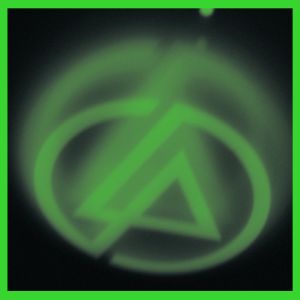 | ||||||
| Compilation by Linkin Park | ||||||
| Recorded: | 2000-2016 | |||||
| Released: | April 12, 2024 | |||||
| Format: | CD, Vinyl, Digital, Cassette | |||||
| Length: | 67:56 | |||||
| ||||||
Papercuts - Singles Collection 2000-2023 is a career-spanning compilation album released by Linkin Park. The album includes a selection of 18 of the band's greatest hits handpicked by the band members themselves as well as the fan favorite song "QWERTY" and a previously unreleased song called "Friendly Fire". The latter was released as the lead single of the album on February 23, 2024, which renders the subtitle Singles Collection 2000-2023 inaccurate.
Composition
Papercuts - Singles Collection 2000-2023 is a collection of the most popular Linkin Park songs, being composed of 16 out of the 18 top streamed Linkin Park songs on Spotify at the time of its release, with "Given Up" (17th most played) and "Heavy" (15th most played) being replaced with "Lost" (24th most played) and "Waiting For The End" (27th most played). The order of the songs was changed to give a better flow to the tracklist.
Because of the method used to pick the songs, the compilation omits Platinum-certified (RIAA) singles "Shadow Of The Day" (23rd most played), "Given Up" and "Heavy".
Papercuts includes songs from every studio album released by Linkin Park with the exception of The Hunting Party. In total, there are four songs from Hybrid Theory, four songs from Meteora, three songs from Minutes To Midnight, one song from A Thousand Suns, two songs from Living Things and one song from One More Light.
Two versions of "Numb" are present on the album, one being the original studio version from Meteora and the other being "Numb/Encore", a mash-up recorded with Jay-Z for the collaborative EP Collision Course.
Other songs in the compilation are "QWERTY", a song recorded during the Minutes To Midnight sessions and originally released on the fan club exclusive EP LP Underground 6.0; "New Divide", a song created during the A Thousand Suns sessions exclusively for the Transformers: Revenge Of The Fallen soundtrack; "Lost", a song from the Meteora sessions released as a single in 2023 to promote the 20th anniversary edition of the album; and "Friendly Fire", a previously unreleased song from the One More Light sessions, during which Linkin Park recorded their last songs with original singer Chester Bennington.
Although "QWERTY", one of the most popular LPU tracks, was previously released in other compilation albums, Papercuts marks the first time the song received a widespread release in digital music platforms. The track was edited especially for the compilation, being similar to the version first included on Songs From The Underground but without the silence at end, making the duration of the track shorter.
Despite being a singles collection, the album versions were used for the majority of the songs included in the compilation instead of their respective single edits. All songs were edited to remove their album transitions and some tracks were made to segue into the next one in order to create a gapless compilation. This process resulted in songs that are different from their album and single counterparts.
In the past Mike Shinoda had stated he was against the idea of doing a greatest hits compilation. In an interview to NME, he explained, “I don’t love putting out Greatest Hits stuff or putting out re-masters of things we’ve done, [so] if we were to do a re-reissue of one of our Linkin Park albums, we want it to be a big deal. If we can’t make it that quality then we won’t do it. If it’s not great then I don’t think we should do it.”[1]
On the press release of the album, he said:
“In the making of each Linkin Park album, I want to love and believe in each individual song completely. I hope that if any one track is heard on its own in the world, it is something I can feel proud of, and something that takes root inside the listener and becomes part of the energy that connects us.
Curating the tracks for Papercuts was a joy. Each song in this collection is both a singular moment on our timeline and an evolving story that is as much ours as it is yours. From our first release ‘One Step Closer’ to the brand-new ‘Friendly Fire,’ this tracklist spans all our chapters so far. Thank you for being a part of our journey. We hope you enjoy Papercuts.” [2]
When questioned why The Hunting Party isn't represented in the compilation, Mike answered, "ask brad why certain songs aren't on it. i voted for more songs"[3]
Kerrang! Track By Track
For the Hybrid Theory (20th Anniversary Edition), Kerrang! Magazine did a track-by-track with Linkin Park of each song on the original album.
As soon as it was a song, I knew that I wanted, personally I wanted at the front of the record. To this day, it feels like it contains so much of the DNA of the band at the time. It was like, it starts with the beat. So the beat was like, at the time, I think was probably influenced a lot by Timbaland - the producer. The guitars kick in, which were at the time very cutting edge, which you would call "nu-metal" now type of sound. It had a real bounce to it but underneath that, there was a drum-n-bass, or jungle beat, happening at the same time. So right away within the first 20 seconds, you're getting three major genre touchpoints, jams together. To me, that stuff only works when you've curated the right pieces. Those three things, when they fit together, I was like, "Damn, I don't know if I've ever put the pieces together in a way that sounds so right." Like, "This is exactly what I want it to sound like." And then the rapping and the lyrics and stuff. In fact, Chester raps the chorus. In fact it's both of us rapping the chorus but we put his vocal way up in the mix. And then it goes from that to the end of the song it goes to a real melodic thing at the end. So all of those things said, there's also a vulnerability and a toughness to it. It really was a well-rounded introduction to Linkin Park.
The only thing about that song that I felt like, "Oh that didn't age super well", is the video. If you watch the video it's like, "I'm sorry, I don't know what we were doing, what was going on." I remember Chester showing up with all plaid, like a whole plaid outfit on. I was thinking, "That's a very weird choice." But it was the type of thing where you had to choose your battles because there was so much on the line, we were just breaking, and like there were minor disagreements on things all the time so I wasn't about to get into a conversation with him about his outfit, when we're just trying to shoot a great video. And the special effects in it are goofy. I get the point of it, I don't think it's a terrible video - I think we've made worse videos. But when I watch it now, I'm kind of like, "I look like a fucking idiot, I don't know what's going on.
One Step Closer was the first song that our record label released to radio. It was actually the first time we actually heard ourselves on the radio. I think we were driving on our first tour bus through Arizona and we actually heard it on the station Chester grew up listening to in Arizona, and then we got home a week later and I heard it on our local station KROQ. And that was super wild. I remember when I was little, listening to the radio, you'd call in and request songs. To actually have a song on the radio was super surreal. I heard that song recently and because we played it live so many times, I have the live version in my head. And when I heard the recorded version recently, which I've listened to from time to time, but haven't paid much attention to - I just love how it sounded. I think Andy Wallace's mix... I think about the song being so heavy because it has so much power live and what I love about the actual song, the recording on Hybrid Theory, is it's not just heavy... it's electronic, it's melodic sounding, there's an alternative quality to the vocal performance. It's just a beautiful song. And that riff, it's probably the riff that I love the most that I've kind of just channeled. While it's the intro of the song, it really serves the backbone of the song, that really syncopated riff.
One funny thing is a lot of guitar players who have covered that song as an homage or something, even professional guitar players, who are way more talented than me, really have trouble with the syncopation. Really guys that you think just shred for whatever reason have a lot of trouble with the syncopation of that riff. It's not technically hard to play, but it's all feel. Certainly the crowd feels it every time we've played it around the world.
So the origin of the song, we worked with these guys by the name of The Dust Brothers. We wanted them to produce a song, they ended up giving us parts of a song. They had a remix that they never put out so it ended up just being samples. We took those samples and started building a track on it. It was like, some little drum breaks in there that became the rhythm track. I think it started off as a hip hop approach so it was obvious to put scratching on there, to use those moments of scratching as breaks in the song. I remember it being something that we were super excited about doing. I guess it was one of the first collaborations that we did, getting parts from someone else. I remember being really excited that song when we were done with it.
I feel like that song came together fairly quickly. Like the chorus was written, the music, and then the words, the lyrics, the melodies came together pretty natural, so that established the climactic moment in the song to strive for, which really gave the setup and intention... meaning the verse and the rapping. I think I did the remix for that on Reanimation, that was fun. With the remix, I remember I had Aceyalone rap who is one of my favorite rappers, especially at that time, and really influential in hip hop and one of the unsung heroes. A guy that not everyone knows about because of the lack of commercial singles on the radio and whatnot, but he was part of this group called the Freestyle Fellowship, which is probably one of the most emulated groups as far as rap style. A lot of what they did influenced some of the southern fast-style rapping and different rhythm flows and time signatures. So for me, it was pretty awesome to work with him along with everyone else on that Reanimation record because it was all people that we looked up to, that we really wanted to collaborate with. The people on that record weren't really the "flavor of the month" type people but really important artists that meant a lot to music at that time.
The thing about Points Of Authority that stands out to me is you can obviously play the riff and it really does highlight the band, and at the same time I think the ethos of that song is deconstructing live music, like, the guitar is chopped up. So you've basically taken live instruments, something organic, and we were really making use of the technology at the time, digital technology, which is stutters and chopping things up. So it's like taking organic ingredients, putting them in a digital blender, and Points Of Authority is what comes up. Mike is the most adept in the group at actually using recording technology. I remember him, when we were young, he'd read manuals for old gear. Like, 80-page manuals, just the most painful literature ever written. That's one of his super-powers: even when he has basic technology, he really learns how to use it. And he almost plays some of the recording technology like an instrument, I think you can hear that on this song.
One thing that's cool about that song is the bridge was different on our demo. A lot of the demos we had before we went into the studio to make Hybrid Theory were slightly different, and I think in totality the changes made the album shine, made it what it is. And as we're re-releasing the record, we went and found all these old tapes. Some of them are actually tapes. [smiles] That's how far back it goes, into the 90s. We became a band really in about 1996 and Hybrid Theory came out in 2000, so some of these songs were kind of in the ether for about five years until we actually got to record them. And there are parts on some of these demos that I think are just as cool or even cooler than the parts that we chose on the album. And I think Points Of Authority actually has a totally different bridge, and I remember listening to it recently and thinking that there's some elements in this demo that I really still love.
So I always wrote my own raps but when it came to all of the singing parts, some songs I would write it, some songs he would write, and some songs we wrote together. But it was usually together. Even if I wrote a thing, which was pretty often, when I gave it to him, we'd go over it. Because I always wanted him to tweak words and make it his own, so when he sang it, his personality was in there. Now "Crawling" was the opposite, where he wrote a lot of those lyrics. He had written the line, "Fear is powerful" in the chorus. We were like (to our producer Don), "How do you like the new lyrics in the song so far?" and he's like, "It's good. I really like that song, "Fear is how I fall."" And we were both like, "Oh yeah, that line... he just heard it wrong. And he heard a really great line by accident. That was one of those things that later on down the line, that we learned to listen to a song and even if we were doing a scat vocal that didn't have real words, you could listen to someone just singing gibberish... you could hear real words in it and sometimes find good gems.
The other thing I'll say about "Crawling"... I didn't know at the time when we won a Grammy for "Best Rock Performance" for that song, I didn't know what "Best Rock Performance" meant when we won it. I thought it was like, "Best Rock Song" was what the award was for. But it was for the studio performance and it's a hundred percent because of the vocal. Like his vocal in that song... it was even hard for him to do some nights on tour and it's impossible for someone else to do it that well. I've never heard anyone else sing it that way... every other cover is a mere shadow of the Chester performance of the song.
Runaway has almost like a punk rock riff at the beginning. That evolved from a song called Stick N Move. We started the band, we were called Xero, and then there was some other Xeros, so we called ourselves Xero 818. It's like what you do if you can't get your Gmail address or Gmail account, you just put a number - that's what bands were doing at that time. And then that didn't work, and then Chester joined the band and we changed the band's name to Hybrid Theory. And then someone told us we had to change it, which is ridiculous, and so we became Linkin Park and the album became Hybrid Theory. And Runaway really kind of tells the tale of that journey.
The original song was written by Mike and Mark, who is actually one of my best friends still, since I was tiny, growing up. He wrote a few of the earliest songs with Mike, and Stick N Move was one of them. This is a super good song. I think there's a version of it that we're including in the Hybrid Theory box set. People use names to classify music because you have to. You have to say "classical music," you have to use names to classify things, otherwise you'd have no place to start. So different classifications were put on the band really early on. The thing that was ironic about classifications is the whole idea of the band early on was to kind of defy classification and actually to take these different genres that were kind of siloed, whether it was our love for rap, love for heavy music, love for alternative music, electronic music - these kind of were more distinct classifications back then. Now we kind of take it for granted more and mash them together into something totally uniquely our own. So yeah, we just called it Hybrid Theory.
So, before Linkin Park we were called Hybrid Theory, that's when Chester joined the band. But before that we had a different singer for a band called Xero, and those two songs came from that batch of songs which made it to the record. Originally with Xero there were three songs that Mike had written with Mark, who was our previous singer, and they're incredible. But there was a problem that occurred. When Brad had gotten ahold of the tape (you know, being best friends with Mark at the time) and he played it for an executive at a music label, and the executive liked what he heard on that three song demo, he was like, "Okay, I want to see the band playing live," and then they were like, "Well, we gotta figure that out," because there was no band, it was two guys. And that's where the origin of the band started. And I think those three songs... I don't think they made it to Hybrid Theory. There was a goal in the type of song we were writing at the time, and a big part of that was to have songs to play live. And so those songs have very suspenseful energy going on, especially in the verses with an outpouring emotion in the choruses. They both have a similar intent as far as the energy that we wanted to convey, and part of that goal was to get this personal inner idea that has conflict. And that was really easy to do, especially because of our age at the time and that universal emotion of not fitting in, and all that kind of "teen angst" as we should call it.
The other intent was to have those songs explode at a certain point, and how that translates live into people just getting really charged up and then like eventually leading to, I guess, more of a "mosh pit" type moment, you know? And that was those early lessons as far as that suspense and release that would relate to people, especially with the right lyrics that people could personalize that type of energy. And even though we don't hear this music too often on the radio, those songs are always on some kind of workout playlist where people need to get charged up and have that energy somehow tapped into and released.
The two songs that have over a billion streams on YouTube are In The End and Numb” So, by the numbers, In The End is our biggest song. The funny thing is that the moment I played that demo for the other guys, they knew that song was special. Chester always said that he didn't get it, he didn't love that song. But I think, in saying that, I think he forgot that there were moments when he did really understand it. He always said like, "The guys should never let me pick singles, because I never understood that song," he's like, "I like it but I never thought it would be as big as it was." The rest of us knew and always felt like that's a huge song. But even he - there were times when we were completely aligned like, "There's something special about the song and we gotta get it right." And the main thing that changed a lot over the course of writing it were the lyrics and the verse, the rest of it stayed very similar to the demo.
If our drummer Rob was here, he would tell you the story he always tells about the song. I had locked myself in our really shady rehearsal space on Hollywood and Vine. And Hollywood and Vine at that time was like drug dealers and prostitutes. Now it's like fancy restaurants, so it's really weird, but at the time it was not a place you would want to walk around at night. And so, I wanted to stay overnight and write there because it was where we rehearsed so all of our gear was there, and I wanted to write with all that stuff within arm's reach. I couldn't do that at home, I was living in an apartment with roommates, so I wanted to be insulated. So I'd stayed there overnight and there's no windows or anything, and I was in these weird days of like... I don't even know how many hours I was there. And eventually the guys showed up and they were like, "How did it go?" And I played them In The End and Rob said, "This is so weird, I was thinking last night, knowing that you were in here writing, I was thinking that we needed a melodic song that was more timeless and more universal, that would be almost bigger in a sense of the songwriting style than anything we had done so far," and he's like, "You did it. This is the song." I don't think we knew it would be this big, but we knew at the time it was the most accessible thing that we had done.
That's one of my favorite songs to play on guitar. It's got a super cool intro. That song was originally called Esaul and I think the demo is also recorded on our Forgotten Tapes as part of the Hybrid Theory box set. Esaul was... our original vocalist Mark was his roommate. So we just called the song like that. We didn't name it after him, it was nonsensically. It's a really intense song and it definitely evolved over time. And there are definitely moments on the demo that just speak for themselves, and there are moments on the Hybrid Theory version that are undeniable. And that's also a song that live has always been a fan favorite. What's super cool about that song live is when we would get to the really intense part of the bridge, we would just stop the music and Chester would be all the way out in the crowd, like crowd surfing, but probably at that point held on top of someone's shoulders, or maybe on top of a security guy, he really just had the crowd in his command and kind of could take it wherever you want. And then, when the intense scream happens in the bridge, it's just like... all hell breaks loose. I remember in the studio with Don there was a process of like, "How do we take the demo and turn it into a more cohesive song?" because the demo lyrically was very abstract. So I think there was an ethos to make it cohesive lyrically and at the same time retain the power and the energy of where the song came from originally.
I mentioned that three song demo, and then after that the band came together and started writing songs. So, that song was a part of that new batch of songs and it was really an exploration on how we can use... I think at the time we had a four track sampler or not a sampler but a four-track tape machine, so you could only record four tracks at the same time, and if you had more than that, you had to bounce onto other tracks with it all on a cassette. So there were definitely limitations. And also limitations of how many seconds of recorded time on a sampler, so you have to just record really important sounds to that. If you compare that to visual art, it's a limited palette, you have a limited amount of colors to deal with. Which I think was great because we took every piece that we added into the music and maximized it. So, with that song in particular, we're in the pursuit of matching the hip-hop side of what we were doing into this heavy build up. It succeeded in a way where I feel like the music that we write these days is smoother, like things kind of meld in, but a lot of the music from the early album were like segments that were just perfectly fit together, like a puzzle, so to speak. They were like - this is the beat, this is where it comes in, this is where it drops... And it worked out perfectly with two vocalists, Chester and Mike, because it created a template for them to really play off of each other, it's like, "how does this cool rapping, that's getting you worked up, build up into this vocal," or "how can there be an A tag worked into a B tag" kind of moment and that's something that was very successful with that song. And I think the concept of that vocal collaboration, whether it be rap from one guy going to rap from another guy, or melody to melody, or rapped melody - every version of that works so well that we were able to take those ideas and take them even further with the rest of the record that we made with Hybrid Theory.
I remember when we were writing the record, we had a certain intention in mind, also having this mission of applying the music that we love, the influences that we love, and incorporating that into what we do, that helped define what ultimately became our sound. And I feel like there was an imbalance. As we're making the Hybrid Theory record there was way more emphasis on the hard rock side, so it wasn't like 50/50. But whenever the hip-hop or electronic side came in, it just made it like... whenever it comes in, it has to be impactful.
So, I remember Mike made that string section as part of just a general beat that he made along with a ton of other beats, and that's really liking the orchestral nature of it, the suspenseful nature of it. And we put a beat to it and then it was like, "Okay, how do we integrate scratching, and glitching, and messing with the beats, in a cool way?" So we just built the track, basically starting from the strings, and then built the rest. And I think the way it played on the record was just the perfect break away from everything else that you were hearing. I think track to track there's a lot of diversity in the type of song and it gives you a good journey, and then you get a nice break before the record finishes. And that's what it does, in the context of the record. And it also shines the light onto the beat production side of what we do. That was always our intention, it's like, "Okay, let's shake things up as much as possible." I think there was a lot of indie stuff that we were listening to, I remember Brad was really listening to - there's a band called Far, this emo band, and Sunny Day Real Estate... I mean, he grew up on heavy metal but he was really into some of that emo stuff at the time. Everyone was listening to different things, and on my side there was a lot of electronic music, particularly from Ninja Tune Records. I think if you hear Cure For The Itch, you could kind of get that vibe and that feeling from it. So, we would definitely strive to emulate the feelings of what those bands did successfully along with all the other ingredients from hip-hop to metal to punk.
I don't know if I'm clear on what led to that song being the last on the record. When we were working on it, either my intention or my direction from other people (meaning probably Don and Brad) was: Crawling is really great and we don't have anything else like that, maybe it would be good to have another song that's kind of in that vein, like - melodic, no rapping, power chords but still with a lot of energy. Because there's a big difference between that and... I would have put Points Of Authority, and Papercut, and With You in a more similar... there's a lot of rhythmic stuff going on there, those were hip-hop tracks gone rock. So, to come at it from the other direction, let's write a Depeche Mode rock song or something. And that's where that came from. I think, actually, Depeche Mode - now that I said that out loud - I think that was really one of my touch points. Brad and I had this love and appreciation for Depeche Mode, so I wanted to start the song with some of those keyboard hook kind of elements. And then we translated some of those to guitar harmonics. The only hip-hop element to me in there is Chester threw in the line "why I played myself this way." When he wrote that, I knew what he was doing, I knew he was trying to use vernacular, that was a little more like... just a tiny bit hip-hop in the words. But the truth was that he would never say those words in real life. So I was always uncomfortable with that line, I was like, "That's not you talking, but I know what you're doing. I know that you’re just trying to glue..." It's smart, you know? In the sense. He's trying to glue the hip-hop component of the band into the lyrics. I just felt like it was a little disingenuous. But that's like neither here nor there, it's a very minor criticism of a song that otherwise I think is a great song, and everybody's participation in the band on it was really strong.
I remember getting that and saying, 'Hey, what do you think of this guy? He just sent us this recording.' I wasn’t like crying with joy, but almost. I was like, ‘Wow, I don’t even know what that is.’ He’s so tiny and vulnerable on the verse and you can hear all those timbres and harmonics and then all the overtones on the heavy part. To me, it just blew my hat off my head. And then we were like, ‘We gotta meet this guy.’
We had made a bunch of demos and at that moment we were looking for a vocalist, and someone… a friend of a friend, had worked with Chester in Arizona. Chester's story – which I'm certain is true – is that he left his own birthday party to go to the studio and record his vocals on the tracks he had sent. That's how excited he was. He'd been in bands for years in Arizona and had basically hit the point where it was harder to get noticed out there, which was frustrating, and by that point he'd got a 9-5 job. And then he got this demo, left the party, recorded the vocals, and the rest is history. I was like, "Holy expletive." It just blew my mind. He sounds like two different people on the same song; the verses sound very, very, vulnerable. That song shows you all of his range: it's got the tiny, tiny, vulnerable verse, which we were able to channel on songs like "Leave Out All The Rest" or "Breaking The Habit" or "One More Light"... and then it’s got the big, melodic, almost-screamy but still-melodic chorus that you’d hear on "Crawling." It had all those elements there and it was like fireworks.
We were just having fun, man. I mean, it was stressful and a lot of the time we didn't know what we were doing, at all. We were just being asked to do things that bands who were blowing up would do and we didn't know how to do any of those things. But the thing that got us through it all was just being ourselves, and knowing that we made a record that we were really proud of, and meeting fans who we connected with through that music. So it was like... everything was a first. I mean, what a spectacular moment in time, you know? Everything was the first, we went in the studio to record a record, first time recording a song in a proper studio, first time working with a producer and an elite engineer who knew what they were doing, who had recorded albums that we had heard of. It was our first time we got a record deal, our first time going on tour in the U.S. When we went to mix the record, it was the first time I'd ever been in New York. Three quarters of my favorite rappers were from New York and I had never even been there! I met Busta Rhymes in the studio while we were mixing, I was like, "This is fucking crazy! We're in the same studio as this guy that I've been listening to for years!" Touring Europe with Deftones for the first time we ever went there. So, that whole ride was insane. And it's shocking and a miracle that we managed to keep our heads on straight and still be good friends and decent human beings at the end of it all.
Releases
Pre-orders for the Papercuts - Singles Collection 2000-2023 launched on February 22, 2024 at 12:15 EST globally. It was released on April 12, 2024 in digital, softpack CD, vinyl 2LP and fluorescent green cassette formats. The latter was marketed as having an extremely limited production.[6]
Several different variations of vinyls were released, with a Black vinyl being the only one widely available. A Clear, Black & Red Splatter vinyl[7] and a Bone vinyl were exclusive to DACH countries (Germany, Austria and Switzerland) in Europe - the Bone vinyl also being exclusive to JPC[8] - and a Yellow & Black Splatter Vinyl was available exclusively to Linkin Park’s top listeners on Spotify.[9] The Bone vinyl was exclusive to Target in the United States and exclusive to JB Hi-Fi in Australia.[10][11] The official Linkin Park store also had two exclusive limited edition vinyl variations with a grayscale version of the cover art, one of them being a Zoetrope designed by Drew Tetz featuring animation that can be viewed with a phone camera and the other one being a Sky Blue & Tangerine Splatter vinyl.[12][13] The Zoetrope Picture Disc was limited to 7,000 units. Other store exclusive variations were a Milky Clear vinyl exclusive to Barnes & Noble[14] and a Dark Grey Recycled Color vinyl exclusive to Walmart.[15] This was the first time that "QWERTY" was made available on vinyl.
Besides standalone items, four bundles were available on the Linkin Park store:
- Papercuts Choice of Album and T-Shirt: includes a Papercuts Reflection Black T-Shirt and a choice between one of five Papercuts album formats.[16]
- Papercuts Vinyl Collectors Bundle: includes Black Vinyl 2LP and Papercuts Zoetrope Picture Disc Vinyl 2LP.[17]
- All Music Bundle: includes Sky Blue & Tangerine Splatter Vinyl 2LP, Zoetrope Picture Disc Vinyl 2LP, Fluorescent Green Cassette, Standard CD, Standard Black Vinyl 2LP.[18]
- Splatter Vinyl & Limited Edition Print (UK Exclusive): This bundle contains the Papercuts Sky Blue & Tangerine Splatter Vinyl 2LP limited pressing featuring special edition gatefold packaging and Papercuts Limited Edition Print - exclusive to UK store customers only. Limited to 300 copies and shipping from Tuesday 16th April this exclusive 12" x 12" print is printed on 300gsm stock with a satin coat.[19]
Pressing Errors
On digital editions of Papercuts, the unedited album versions of the songs were included in the compilation. As a result, "Leave Out All The Rest" has the transition to "Bleed It Out" at the end of the song and "Papercut" has the transition to "One Step Closer" at the end despite the songs not being in sequence in the compilation. In addition to that, a few songs include transitions to songs not present in the compilation such as "Breaking The Habit", which includes the transition to "From The Inside", and "Waiting For The End", which includes the transition to "Blackout". Songs like "Somewhere I Belong", "Faint", "Breaking The Habit", "Bleed It Out" and "What I've Done" which originally transitioned from other tracks have the transition start.
Fans have reported that some CD and vinyl pressings of Papercuts have versions of the songs with their original album transitions while others have the songs without transitions, like "[[.[20][21]
The center label of vinyls have a length of 4:24 for "Friendly Fire" instead of 2:56. Other songs have the length of their respective album versions.[22][23]
Some fans who ordered the Zoetrope Picture Disc received only one Zoetrope disc, with the second disc being from the Dark Grey Recycled Color vinyl.[24]
Track Listing
| No. | Title | Writer(s) | Originally Released | Length |
|---|---|---|---|---|
| 1 | Crawling | Linkin Park | Hybrid Theory (2000) | 3:29 |
| 2 | Faint | Linkin Park | Meteora (2003) | 2:42 |
| 3 | Numb/Encore | Linkin Park | Collision Course (2004) | 3:26 |
| 4 | Papercut | Linkin Park | Hybrid Theory (2000) | 3:04 |
| 5 | Breaking The Habit | Linkin Park | Meteora (2003) | 3:16 |
| 6 | In The End | Linkin Park | Hybrid Theory (2000) | 3:36 |
| 7 | Bleed It Out | Linkin Park | Minutes To Midnight (2007) | 2:44 |
| 8 | Somewhere I Belong | Linkin Park | Meteora (2003) | 3:34 |
| 9 | Waiting For The End | Linkin Park | A Thousand Suns (2010) | 3:51 |
| 10 | Castle Of Glass | Linkin Park | Living Things (2012) | 3:25 |
| 11 | One More Light | Linkin Park | One More Light (2017) | 4:15 |
| 12 | Burn It Down | Linkin Park | Living Things (2012) | 3:50 |
| 13 | What I've Done | Linkin Park | Minutes To Midnight (2007) | 3:25 |
| 14 | QWERTY | Linkin Park | LP Underground 6.0 (2006) | 3:21 |
| 15 | One Step Closer | Linkin Park | Hybrid Theory (2000) | 2:35 |
| 16 | New Divide | Linkin Park | Transformers: Revenge Of The Fallen (2009) | 4:29 |
| 17 | Leave Out All The Rest | Linkin Park | Minutes To Midnight (2007) | 3:29 |
| 18 | Lost | Linkin Park | Meteora (20th Anniversary Edition) (2023) | 3:19 |
| 19 | Numb | Linkin Park | Meteora (2003) | 3:07 |
| 20 | Friendly Fire | Linkin Park | Previously Unreleased | 2:56 |
- Note: The track lengths were taken from the digital edition of the album and may differ from physical editions due to pressing errors.
Personnel
Linkin Park
- Chester Bennington
- Rob Bourdon
- Brad Delson
- Phoenix
- Joe Hahn
- Mike Shinoda
Production
- Tracks 1, 4, 6, 15 Produced by Don Gilmore
- Tracks 2, 5, 8, 18, 19 Produced by Don Gilmore and Linkin Park
- Tracks 7, 9, 10, 12, 13, 14, 17 Produced by Rick Rubin and Mike Shinoda
- Tracks 3, 16 Produced by Mike Shinoda
- Tracks 11, 20 Produced by Mike Shinoda and Brad Delson
Management
- Worldwide Representation: Machine Shop Entertainment - Bill Silva, Ryan DeMarti, Trish Evangelista and Lorenzo Errico
- Booking Agency: Dennis Arfa and Michael Arfin of Artist Group International
- Europe Booking Agency: Scott Thomas, Jennie Wells and Sarah Medley of X-Ray Touring
- Legal for Linkin Park: David Lande, David Byrnes, Mitch Tenzer and Irina Volodarsky for Ziffren Brittenham LLP
- Business Affairs for Warner Records: Atticus George Carroll
- Business Managers: Todd Gelfand, Jeff Gillman, Gloria Balanay and Michael Altschuler for Gelfand, Rennert & Feldman, LLP
- Publicity: Laura Swanson for Warner Records
- UK Publicity: Lauren Hales
- A&R Coordination: Ryan DeMarti and Robin Hurley
- Marketing Director: Peter Standish
Artwork
- Photography: Brian Ziff
- Creative Direction and Design: Frank Maddocks
- Special Thanks: LPU and LP Street Soldiers everywhere
Promotion
Gallery
-
Cover
-
CD with sticker
-
Black vinyl
-
Dark Grey Recycled Color vinyl
-
Black vinyl with sticker
-
Bone vinyl
-
Bone vinyl with Target sticker
-
Milky Clear vinyl
-
Clear, Black & Red Splatter vinyl
-
Clear, Black & Red Splatter vinyl with sticker
-
Yellow & Black Splatter vinyl
-
Blue & Tangerine Splatter vinyl
-
Zoetrope Picture Disc vinyl
-
Zoetrope Picture Disc Side 02 animation
-
Zoetrope Picture Disc Side 03 animation
-
Vinyl tracklist
-
Official store exclusive vinyls tracklist
-
Fluorescent Green cassette tape
-
Reflection Tee front
-
Reflection Tee back
-
Shadows Hoodie front
-
Shadows Hoodie back
-
All Music Bundle
-
Choice Of Album And T-Shirt Bundle
-
Papercuts Shadow Turntable Slipmat
-
Papercuts LPU Repeater Turntable Slipmat
-
EMP exclusive bundle
-
EMP exclusive bundle
-
Linkin Park Complete Playlist
-
Title
-
Banner
-
Pre-order banner
-
Store background
-
Brad Delson's letter
-
Artwork reveal from Joe Hahn's Instagram stories
-
Most played Linkin Park songs on Spotify at the time of release
External Links
References
- ↑ Mike Shinoda: “I want to put out music, but I also want to do more with it”, November 24, 2023
- ↑ LINKIN PARK DELIGHT FANS WITH ANNOUNCE OF CAREER-SPANNING ALBUM PAPERCUTS (SINGLES COLLECTION 2000-2023) / News / Warner Music New Zealand, February 23, 2024
- ↑ Linkin Park Live on X: "We have answers about #TheHuntingParty! Paging Brad Delson 📣 https://t.co/2ZcnpGT26F" / X, February 25, 2024
- ↑ 4.00 4.01 4.02 4.03 4.04 4.05 4.06 4.07 4.08 4.09 4.10 4.11 4.12 YouTube: KERRANG! - LINKIN PARK: Hybrid Theory - The Inside Story as told by the band October 23, 2020
- ↑ YouTube: Linkin Park - Brad Delson About "Pictureboard", October 2022
- ↑ Papercuts Limited Edition Fluorescent Green Cassette | Linkin Park Official Store
- ↑ Linkin Park: Papercuts (Singles Collection 2000-2023) (Limited Indie Exclusive Edition) (Clear, Black & Red Splatter Vinyl) (2 LPs) – jpc
- ↑ Linkin Park: Papercuts (Singles Collection 2000-2023) (Limited Edition) (Bone Vinyl) (in Deutschland/Österreich/Schweiz exklusiv für jpc!) (2 LPs) – jpc
- ↑ PAPERCUTS LIMITED EDITION SPOTIFY EXCLUSIVE YELLOW & BLACK SPLATTER VINYL 2LP | Linkin Park Official Store
- ↑ Linkin Park - Papercuts (target Exclusive, Vinyl) (bone Colored) (2lp) : Target
- ↑ Papercuts (JB Hi-Fi AU Exclusive Bone Coloured Vinyl)
- ↑ Papercuts Limited Edition Zoetrope Picture Disc Vinyl 2LP | Linkin Park Official Store
- ↑ Papercuts Limited Edition Sky Blue & Tangerine Splatter Vinyl 2LP | Linkin Park Official Store
- ↑ Papercuts (Milky Clear Vinyl) (Barnes & Noble Exclusive) by Linkin Park | Vinyl LP | Barnes & Noble®
- ↑ Linkin Park - Papercuts (Walmart Exclusive Dark Grey Recycled Color Vinyl) - Rock 2 LP - Walmart.com
- ↑ Papercuts Choice Of Album & T-Shirt | Linkin Park Official Store
- ↑ Papercuts Limited Edition Vinyl Collectors Bundle | Linkin Park Official Store
- ↑ Papercuts All Music Bundle | Linkin Park Official Store
- ↑ Splatter Vinyl & Limited Edition Print - UK Exclusive | Linkin Park Official Store
- ↑ The Papercuts shenanigans just got weirder : r/LinkinPark, April 13, 2024
- ↑ Linkin Park Live on X: "We heard a couple of reports about vinyls having single versions, so it might be something with the CD and digital editions only. Have you purchased a physical copy of Papercuts? Let us know which edition you got and which version of the songs (album or single) is included in it" / X, April 13, 2024
- ↑ Linkin Park – Papercuts (2024, Bone White, Vinyl) - Discogs
- ↑ Linkin Park Live on X: "Can everyone who has a vinyl for #Papercuts let us know what the vinyl shows as a track time for Friendly Fire? :)" / X, April 18, 2024
- ↑ Lorenzo on X: "@LPLive we are aware that a few of the zoetrope records shipped this way and are working with @WMG_Support @WMG_support_EU" / X, April 18, 2024
